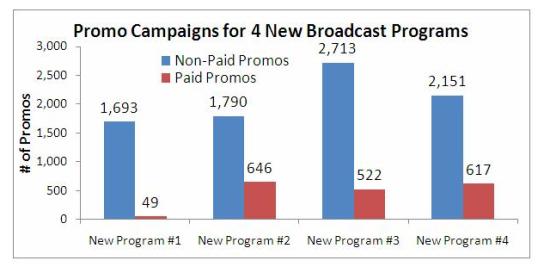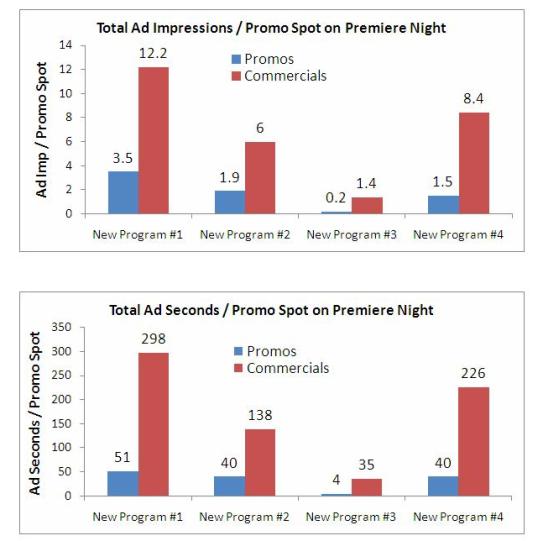Simulmedia: Measuring the Return on Investment of a Promotional Campaign - Stewart Hauser - MediaBizBloggers

Like most television advertisers, marketers promoting television programming are haunted by what we'll call the Wanamakerian spectre. The spectre whispers in the ears of network marketers: "You know half your spending on advertising is wasted and you don't know which half." The superior measurement afforded by set-top box data gives network marketers the tools to determine which part of their promotional spending is working and banish the spectre.
Programs with high ratings can command high advertising fees, since large numbers of people will be available to watch advertisements during the show. The ultimate value of a marginal viewer to a program depends on the number of ads that the new viewer will watch while tuned in to the program. In other words, new viewers mean more people to watch ads, which raises the price that advertisers can charge for future spots.
In this context, we can analyze promotional campaigns based on the number of ad impressions and the seconds of ads watched per promo spot. This "return on investment" or ROI of a promotional campaign can be useful in determining which campaigns are the most effective and efficient, and how to better structure campaigns in the future. Set-top box data proves to be an essential component of these evaluations.
To investigate these ideas, we selected four new broadcast programs on several different broadcast channels. The series all premiered in September 2009 and had promotional campaigns that began in late May or early June 2009. We can start by examining the number of promotions in each of these campaigns, starting from the beginning of the campaign and ending with the night of the series premiere:
Non-paid promos are promos run on-channel or on sister channels, while paid promos are run on competing channels. Each of these campaigns was significant in size, featuring over 1,500 non-paid promos in all cases. The campaign for program #1 used almost no paid promos, while the other campaigns each used around 500 or 600. Since these are new programs, we can assume that the promotions are mostly responsible for driving viewers to the series premiere, rather than, say, loyalty to or awareness of the program from a previous season.
The next step is quantifying the return on investment generated by each of these campaigns. Clearly, the number of ad impressions matters a lot—marketers want viewers to be exposed to as many ads as possible. There are other variables to consider, though, such as total seconds of advertisements watched.
In terms of time frames, there are various ways that the data could be sliced. Do we only give a pre-premiere promotional campaign credit for ads viewed during the series premiere of the program? Can we take some amount of credit for ads viewed later that night on the same network, or on future episodes of the program? Finally, do we take credit for everyone who tunes into the series premiere, or only people who tuned in after first seeing a promotion?
There are many ways to consider the data, but for now we can start with two metrics: Total ad impressions per promo spot, and total seconds of advertisements viewed per promo spot. We'll look only at the premiere night, but take credit for ads viewed both during and after our programs on the relevant networks.
We will examine only people who saw at least one promotion and then tuned into the series premiere; it doesn't make sense to take credit for viewers who made it to the premiere without having seen a promo.
The following two graphs show the initial ROI results for the four programs:
Ad time viewed is divided between promotions and commercials, since marketers will likely be interested not only in the number of advertisements watched or the time spent watching advertisements, but also in the relative split between ads for, say, restaurants and basketball shoes compared to promotions for future programs. The graphs include ad time for people who saw at least one promotion before the series premiere and then tuned into at least six minutes of the premiere.
The first graph demonstrates that the promo campaign for Program #1 was the most efficient, in the sense that it yielded the highest number of ad impressions per promo spot. The majority of these ad impressions were commercials as opposed to promos. The second graph looks at seconds of commercials viewed, rather than impressions. Not surprisingly, there seems to be a very strong correlation between impressions per promo spot and total seconds per promo spot. If we did happen to find a campaign that yielded relatively high impressions but relatively low total seconds viewed, there would be two possible explanations: Viewers of that program were much more likely than other viewers to tune away from advertisements, or the ads aired during that program just tended to be shorter in duration than the ads on the other programs.
Overall, the promo campaign for Program #1 seems to have been the most efficient, while the campaign for Program #3 was the least efficient. The campaign for Program #3 had far more promos than any of the other campaigns, which led to the low efficiency. There is certainly a difference between efficiency and effectiveness, but the two items do tend to be related.
ROI is a good way to measure the effectiveness of a promotional campaign. There are many different decisions that need to be made in such a calculation, but the bottom line is that set-top box data can be used to compare different promotional campaigns and in doing so, determine the best ways to promote a program.
Data based on KantarMedia's InfoSys data product using DIRECTV data.
Stewart can be reached at stewart@simulmedia.com.
Read all Stewart's MediaBizBloggers commentaries at Simulmedia - MediaBizBloggers.
Follow our Twitter updates @MediaBizBlogger




